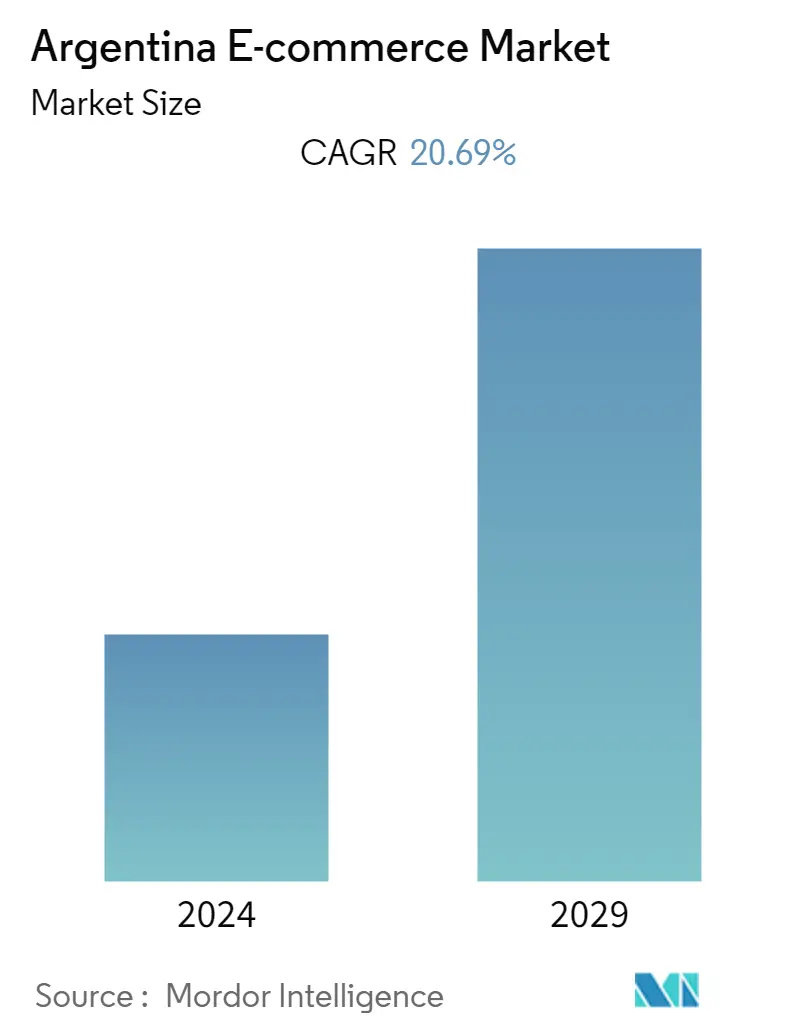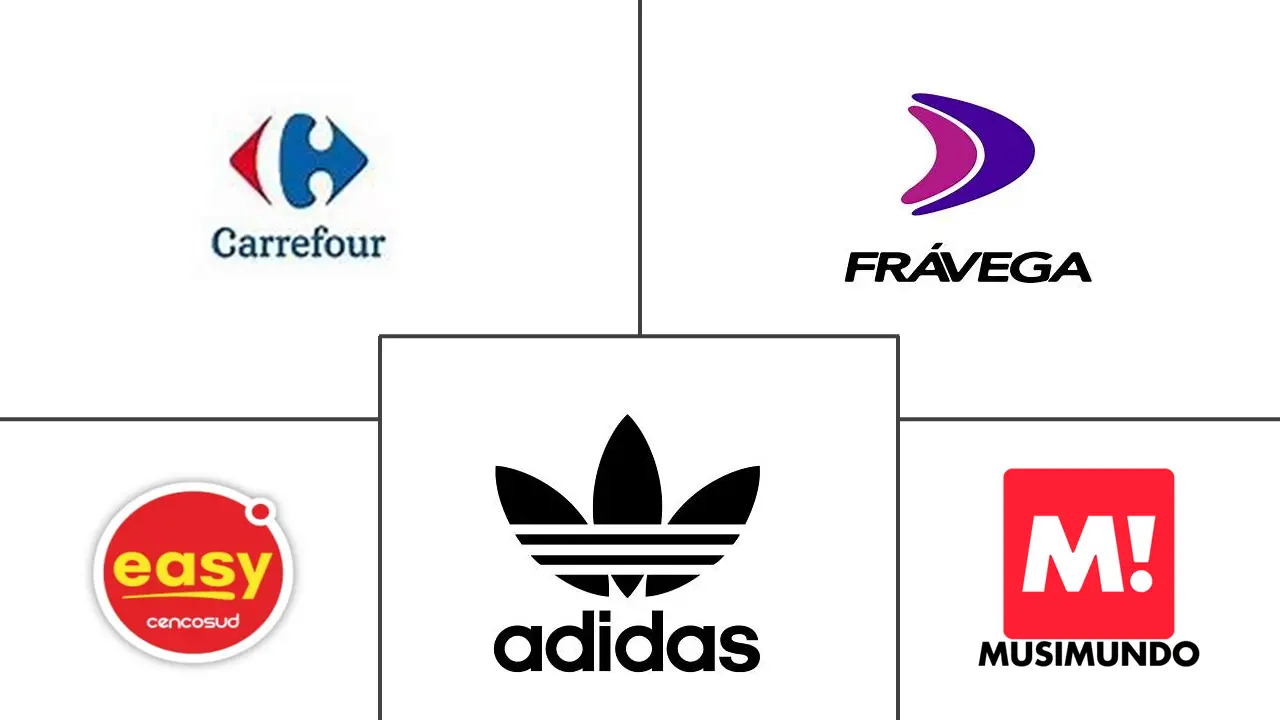Market Size of Argentina E-commerce Industry

| Study Period | 2019 - 2029 |
| Base Year For Estimation | 2023 |
| Forecast Data Period | 2024 - 2029 |
| Historical Data Period | 2019 - 2022 |
| CAGR | 20.69 % |
| Market Concentration | Medium |
Major Players
*Disclaimer: Major Players sorted in no particular order |
Argentina E-commerce Market Analysis
Argentina's E-commerce Market is expected to grow at a CAGR of 20.69 % from 2022 to 2027. Carrefour is the largest player in the Argentine e-commerce Market. In 2021, the store made $286 million in revenue. It is followed by adidas.com.ar, which has a revenue of US$250 million, and Walmart.com.ar, which has a revenue of US$193 million. The top three stores account for 10% of all online revenue in Argentina.
- In the next four years, the Argentine market is expected to be one of the fastest-growing. Because of the increased use of mobile devices and the consumer characteristics of this country, companies looking to invest in Latin America find Argentina to be a promising and effective scenario for competing in global e-commerce.
- MercadoLibre, a Buenos Aires-based online marketplace, is also boosting e-commerce in Argentina. According to eMarketer, MercadoLibre is to Latin America what "Amazon is to the United States" or "Alibaba is to China." The platform has over 267 million registered users, the majority of whom are from Latin America. In 2019, MercadoLibre generated nearly $2.3 billion in net revenue, a 60% increase over the previous year. Argentina contributed $456 million.
- There are many strong reasons to target Argentina with e-commerce; the market is still progressing and not without barriers. It has an unstable economy and a high inflation rate, which has reduced Argentine consumers' purchasing power.
- Argentina faces an uncertain situation between 2020 and 2021 due to the COVID-19-driven fintech boom. The country has had some success with digital banking, such as the digital wallet MODO or the Estrategia Nacional de Inclusión Financiera (ENIF, as the Spanish-language acronym suggests).
- 90% of online Argentine adults (18.3 million people) have made at least one purchase. Argentina's e-commerce increased by 124% in 2020 after rising by 76% in 2019, with growth likely to continue in 2021 due to the extended quarantine imposed for the COVID-19 pandemic.
Argentina E-commerce Industry Segmentation
E-commerce is the purchasing and selling of products and services over the Internet. It is conducted over computers, mobiles, tablets, and other smart devices. There are primarily two types of e-commerce, including Business-to-Consumer (B2C) and Business-to-Business (B2B).
The Argentina E-commerce Market is segmented into B2C E-Commerce (Beauty and Personal Care, Consumer Electronics, Fashion and Apparel, Food and Beverage, Furniture and Home), and B2B E-Commerce.
| By B2C e-commerce | ||||||||
| Market size (GMV) for the period of 2017-2027 | ||||||||
|
| By B2B e-commerce | |
| Market size for the period of 2017-2027 |
Argentina E-commerce Market Size Summary
The Argentine e-commerce market is poised for significant growth, driven by increasing mobile device usage and a burgeoning online shopping culture. Major players like Carrefour, adidas.com.ar, and Walmart.com.ar dominate the market, collectively accounting for a substantial portion of online revenue. MercadoLibre, often compared to Amazon and Alibaba, plays a pivotal role in shaping the e-commerce landscape in Argentina, boasting a vast user base and impressive revenue growth. Despite economic challenges such as high inflation and unstable economic conditions, the market continues to expand, with a notable shift towards digital banking and payment solutions. The rise of mobile commerce further underscores the dynamic nature of the market, although some retailers have been slow to adapt to mobile-friendly platforms.
Argentina's e-commerce sector is characterized by a diverse range of product categories, with electronics and media leading the charge, followed by fashion, furniture, and personal care items. The market's growth is supported by a high percentage of internet users and a strong preference for credit card payments, although digital wallets are gaining traction. The introduction of international services like Amazon Music Unlimited highlights the market's potential for cross-border e-commerce. As the market evolves, companies are increasingly recognizing Argentina as a promising destination for investment in Latin America's digital economy, despite the existing economic hurdles.
Argentina E-commerce Market Size - Table of Contents
-
1. MARKET INSIGHTS
-
1.1 Market Overview
-
1.2 Industry Attractiveness-Porter's Five Forces Analysis
-
1.2.1 Bargaining Power of Suppliers
-
1.2.2 Bargaining Power of Buyers/Consumers
-
1.2.3 Threat of New Entrants
-
1.2.4 Threat of Substitute Products
-
1.2.5 Intensity of Competitive Rivalry
-
-
1.3 Key market trends and share of e-commerce of total Retail sector
-
1.4 Impact of COVID-19 on the e-commerce sales
-
-
2. Market Segmentation
-
2.1 By B2C e-commerce
-
2.1.1 Market size (GMV) for the period of 2017-2027
-
2.1.2 Market Segmentation - by Application
-
2.1.2.1 Beauty & Personal Care
-
2.1.2.2 Consumer Electronics
-
2.1.2.3 Fashion & Apparel
-
2.1.2.4 Food & Beverage
-
2.1.2.5 Furniture & Home
-
2.1.2.6 Others (Toys, DIY, Media, etc.)
-
-
-
2.2 By B2B e-commerce
-
2.2.1 Market size for the period of 2017-2027
-
-
Argentina E-commerce Market Size FAQs
What is the current Argentina E-commerce Market size?
The Argentina E-commerce Market is projected to register a CAGR of 20.69% during the forecast period (2024-2029)
Who are the key players in Argentina E-commerce Market?
Carrefour Argentina , Adidas , Fravega, Easy.com, Musimundo, Amazon and Mercado Libre Argentina are the major companies operating in the Argentina E-commerce Market.

